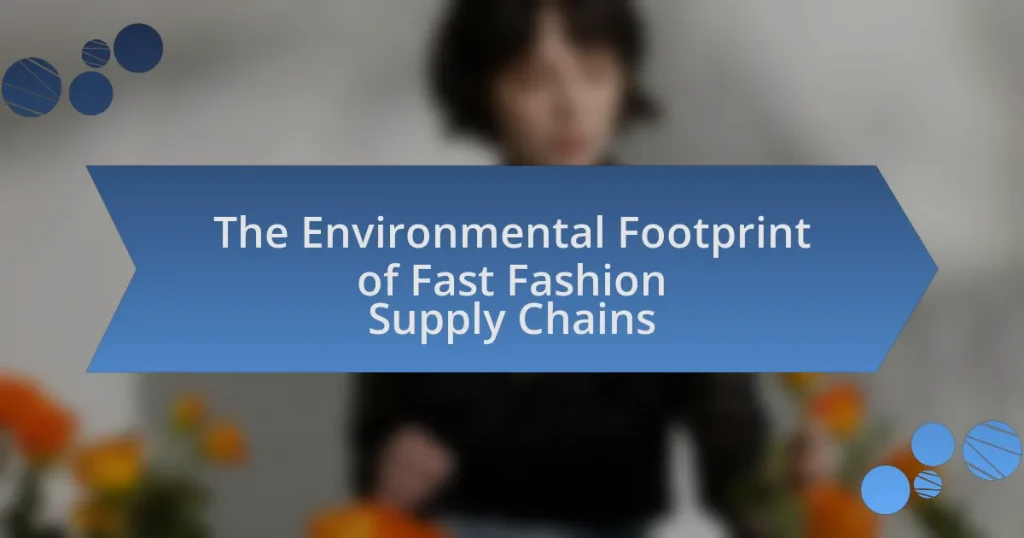The environmental footprint of fast fashion supply chains is substantial, contributing to approximately 10% of global carbon emissions and generating around 92 million tons of textile waste annually. This industry is characterized by excessive resource consumption, including significant water usage—up to 2,700 liters for a single cotton shirt—and pollution from toxic chemicals used in production. Key stages of the fast fashion supply chain, such as design, manufacturing, and disposal, exacerbate environmental degradation through resource depletion and waste generation. Understanding these impacts is crucial for promoting sustainable practices and reducing the ecological consequences associated with fast fashion.

What is the Environmental Footprint of Fast Fashion Supply Chains?
The environmental footprint of fast fashion supply chains is significant, characterized by high levels of resource consumption and pollution. Fast fashion contributes to approximately 10% of global carbon emissions, primarily due to energy-intensive production processes and transportation. Additionally, the industry is responsible for the use of vast amounts of water, with estimates suggesting that producing a single cotton shirt can require up to 2,700 liters of water. Furthermore, fast fashion generates substantial textile waste, with around 92 million tons of waste produced annually, much of which ends up in landfills. These statistics underscore the detrimental impact of fast fashion on the environment, highlighting the urgent need for sustainable practices within the industry.
How does fast fashion contribute to environmental degradation?
Fast fashion contributes to environmental degradation primarily through excessive resource consumption and waste generation. The production of fast fashion items requires vast amounts of water, with the fashion industry consuming approximately 79 billion cubic meters of water annually, which leads to water scarcity in many regions. Additionally, the use of synthetic fibers, such as polyester, results in microplastic pollution, as these materials shed tiny particles during washing, contaminating oceans and harming marine life.
Moreover, fast fashion promotes a culture of disposability, with consumers often discarding clothing after only a few wears. This behavior contributes to the staggering statistic that the fashion industry is responsible for 10% of global carbon emissions, equivalent to the emissions produced by the entire European Union. The rapid production cycles also lead to significant chemical pollution, as toxic dyes and finishing agents are often released into waterways without proper treatment.
In summary, fast fashion’s reliance on unsustainable practices and its promotion of a throwaway culture significantly exacerbate environmental degradation through resource depletion, pollution, and greenhouse gas emissions.
What are the key stages in the fast fashion supply chain?
The key stages in the fast fashion supply chain include design, sourcing, manufacturing, distribution, retail, and post-consumer disposal. The design stage involves creating new clothing lines based on current trends, often with rapid turnaround times. Sourcing entails selecting materials and suppliers, frequently prioritizing cost and speed. Manufacturing is the production phase, where garments are made, often in low-cost countries to minimize expenses. Distribution involves transporting finished products to retail locations, emphasizing efficiency to meet consumer demand quickly. Retail is the stage where products are sold to consumers, often through both physical stores and online platforms. Finally, post-consumer disposal addresses the environmental impact of discarded clothing, highlighting the need for sustainable practices as fast fashion contributes significantly to textile waste. According to the Ellen MacArthur Foundation, the fashion industry is responsible for 92 million tons of waste annually, underscoring the importance of addressing these stages for environmental sustainability.
How do these stages impact the environment?
The stages of fast fashion supply chains significantly impact the environment by contributing to pollution, resource depletion, and waste generation. The production stage often involves the use of toxic chemicals and dyes, which can contaminate water sources; for instance, the textile industry is responsible for 20% of global wastewater. Additionally, the extraction of raw materials, such as cotton, requires substantial water resources, leading to water scarcity in regions where these materials are sourced. The transportation stage adds to carbon emissions, with the fashion industry accounting for about 10% of global greenhouse gas emissions. Finally, the disposal stage results in massive amounts of textile waste, with over 92 million tons of textiles discarded annually, contributing to landfill overflow and environmental degradation.
Why is it important to analyze the environmental footprint?
Analyzing the environmental footprint is crucial because it quantifies the ecological impact of activities, particularly in industries like fast fashion. This analysis helps identify areas where resource consumption and waste generation can be reduced, leading to more sustainable practices. For instance, the fast fashion industry is responsible for approximately 10% of global carbon emissions and significant water pollution, highlighting the urgent need for assessment and improvement. By understanding these impacts, companies can implement strategies to minimize their environmental harm, comply with regulations, and meet consumer demand for sustainable products.
What are the long-term effects of fast fashion on ecosystems?
The long-term effects of fast fashion on ecosystems include significant biodiversity loss, soil degradation, and water pollution. Fast fashion contributes to the depletion of natural resources, as the production processes often require large amounts of water and energy, leading to habitat destruction. For instance, the fashion industry is responsible for 20% of global wastewater, which contaminates rivers and oceans with toxic chemicals used in dyeing and finishing processes. Additionally, the rapid turnover of clothing leads to increased textile waste, with over 92 million tons discarded annually, further straining landfills and ecosystems. These factors collectively disrupt ecological balance and threaten wildlife, highlighting the urgent need for sustainable practices in the fashion industry.
How does consumer behavior influence the environmental footprint?
Consumer behavior significantly influences the environmental footprint by determining the demand for fast fashion products, which in turn drives production practices that often prioritize speed and cost over sustainability. When consumers opt for low-cost, trendy clothing, they contribute to increased resource extraction, waste generation, and carbon emissions associated with the fast fashion industry. For instance, a study by the Ellen MacArthur Foundation indicates that the fashion industry is responsible for 10% of global carbon emissions, largely fueled by consumer demand for inexpensive and rapidly produced garments. Additionally, consumers’ preferences for disposable fashion lead to shorter product lifecycles, resulting in higher volumes of textile waste; the World Bank estimates that 92 million tons of textile waste are generated annually, much of which comes from fast fashion consumption patterns.
What are the main components of the environmental footprint?
The main components of the environmental footprint include carbon emissions, water usage, land use, and waste generation. Carbon emissions arise from energy consumption during production and transportation processes, contributing significantly to climate change. Water usage encompasses the amount of water required for growing raw materials, manufacturing, and dyeing processes, with the fashion industry being a major consumer. Land use refers to the area needed for agriculture, production facilities, and waste disposal, impacting biodiversity and ecosystems. Waste generation includes the discarded materials and products that contribute to landfill overflow and pollution, highlighting the unsustainable practices within fast fashion supply chains.
How do water usage and pollution factor into fast fashion?
Water usage and pollution are critical factors in fast fashion, as the industry consumes vast amounts of water and generates significant waste. The production of a single cotton t-shirt requires approximately 2,700 liters of water, which is enough for one person to drink for two and a half years. Additionally, the dyeing and finishing processes in textile manufacturing often involve toxic chemicals that contaminate water sources, leading to pollution that affects local ecosystems and communities. Studies indicate that the fast fashion industry is responsible for about 20% of global wastewater, exacerbating water scarcity and environmental degradation.
What role does carbon emissions play in the supply chain?
Carbon emissions significantly impact the supply chain by contributing to climate change and influencing regulatory compliance, operational costs, and consumer preferences. The fast fashion industry, for instance, is responsible for approximately 10% of global carbon emissions, primarily due to energy-intensive production processes, transportation, and waste management. This high level of emissions not only affects the environment but also leads to increased scrutiny from governments and consumers, pushing companies to adopt more sustainable practices. As a result, businesses face pressure to reduce their carbon footprint, which can lead to changes in sourcing materials, optimizing logistics, and implementing eco-friendly technologies.
How can we measure the environmental impact of fast fashion?
The environmental impact of fast fashion can be measured through various metrics, including carbon emissions, water usage, and waste generation. For instance, the Global Fashion Agenda’s 2020 report highlights that the fashion industry accounts for approximately 10% of global carbon emissions, emphasizing the significant role of fast fashion in climate change. Additionally, the Water Footprint Network indicates that producing a single cotton t-shirt requires about 2,700 liters of water, illustrating the extensive water consumption associated with fast fashion. Furthermore, the Ellen MacArthur Foundation reports that over 92 million tons of textile waste are generated annually, with a substantial portion stemming from fast fashion practices. These metrics provide a comprehensive framework for assessing the environmental consequences of fast fashion.
What metrics are used to assess environmental footprints?
Metrics used to assess environmental footprints include carbon footprint, water footprint, ecological footprint, and waste footprint. The carbon footprint measures greenhouse gas emissions associated with production and consumption, typically expressed in carbon dioxide equivalents. The water footprint quantifies freshwater usage throughout the supply chain, accounting for both direct and indirect water consumption. The ecological footprint evaluates the land area required to sustain resource consumption and absorb waste, providing insight into the sustainability of practices. The waste footprint assesses the total waste generated, including solid and liquid waste, during the lifecycle of products. These metrics are essential for understanding the environmental impacts of fast fashion supply chains and guiding improvements in sustainability practices.
How do life cycle assessments contribute to understanding impact?
Life cycle assessments (LCAs) contribute to understanding impact by providing a comprehensive evaluation of the environmental effects associated with all stages of a product’s life, from raw material extraction to disposal. LCAs quantify resource use, emissions, and waste generation, enabling stakeholders to identify critical areas for improvement in sustainability practices. For instance, a study published in the Journal of Cleaner Production found that LCAs of fast fashion items revealed that over 70% of their environmental impact occurs during the production phase, highlighting the need for more sustainable manufacturing processes. This data-driven approach allows companies to make informed decisions that reduce their overall environmental footprint.
What are the alternatives to fast fashion that reduce environmental impact?
Sustainable fashion practices serve as effective alternatives to fast fashion that significantly reduce environmental impact. These practices include using organic or recycled materials, which minimize resource depletion and pollution. For instance, organic cotton farming uses 91% less water than conventional cotton farming, according to the Textile Exchange. Additionally, second-hand shopping and clothing swaps extend the lifecycle of garments, reducing waste; the Ellen MacArthur Foundation reports that extending the life of clothes by just nine months can reduce carbon, water, and waste footprints by 20-30%. Furthermore, brands that adopt slow fashion principles focus on quality over quantity, producing fewer items that are designed to last, thereby decreasing the overall demand for new resources.
How do sustainable fashion practices differ from fast fashion?
Sustainable fashion practices prioritize environmental and social responsibility, contrasting sharply with fast fashion’s focus on rapid production and low costs. Sustainable fashion emphasizes the use of eco-friendly materials, ethical labor practices, and long-lasting designs, aiming to reduce waste and carbon footprints. In contrast, fast fashion relies on cheap, synthetic materials and exploitative labor conditions to produce high volumes of clothing quickly, often leading to significant environmental degradation. For instance, the Ellen MacArthur Foundation reports that the fashion industry is responsible for 10% of global carbon emissions, largely driven by fast fashion practices.
What role do second-hand markets play in reducing the footprint?
Second-hand markets significantly reduce the environmental footprint by extending the lifecycle of clothing and minimizing waste. By facilitating the reuse of garments, these markets decrease the demand for new production, which is resource-intensive and contributes to pollution. For instance, a study by the Ellen MacArthur Foundation indicates that extending the life of clothing by just nine months can reduce carbon, water, and waste footprints by around 20-30%. This demonstrates that second-hand markets play a crucial role in promoting sustainability within the fast fashion industry by lowering overall consumption and resource depletion.
What actions can consumers take to minimize their environmental footprint?
Consumers can minimize their environmental footprint by adopting sustainable purchasing habits, such as buying less, choosing eco-friendly products, and supporting ethical brands. Research indicates that the fashion industry is responsible for 10% of global carbon emissions, highlighting the impact of consumer choices. By opting for high-quality, durable clothing and participating in clothing swaps or second-hand shopping, consumers can significantly reduce waste and resource consumption. Additionally, washing clothes in cold water and air-drying can decrease energy use, further contributing to a lower environmental footprint.
How can consumers make more sustainable fashion choices?
Consumers can make more sustainable fashion choices by opting for eco-friendly brands, purchasing second-hand clothing, and prioritizing quality over quantity. Eco-friendly brands often use sustainable materials and ethical production practices, which significantly reduce environmental impact. For instance, brands that utilize organic cotton or recycled materials contribute to lower water usage and reduced waste. Purchasing second-hand clothing extends the lifecycle of garments, thereby minimizing the demand for new production, which is a major contributor to pollution and resource depletion. Prioritizing quality ensures that consumers invest in durable items that last longer, reducing the frequency of purchases and waste. According to a report by the Ellen MacArthur Foundation, extending the life of clothing by just nine months can reduce carbon, water, and waste footprints by 20-30%.
What are some practical tips for reducing waste in fashion consumption?
To reduce waste in fashion consumption, individuals can adopt several practical strategies. First, purchasing second-hand clothing significantly decreases demand for new production, thereby minimizing waste; studies show that buying used garments can reduce carbon emissions by up to 73% compared to new items. Second, consumers should prioritize quality over quantity by investing in durable clothing that lasts longer, which reduces the frequency of replacements and waste generation. Third, practicing mindful consumption, such as creating a capsule wardrobe, helps limit unnecessary purchases and encourages versatility in outfits. Additionally, recycling and donating unwanted clothing ensures that items are reused rather than ending up in landfills, where textile waste contributes to environmental degradation. Lastly, supporting sustainable brands that utilize eco-friendly materials and ethical production practices can further mitigate the environmental impact of fashion consumption.















